|  |
 Salute, energia e chiarezza mentale sono nelle nostre mani. È questo il principio dei Mudra, i sacri sigilli praticati da oltre cinquemila anni per la ricerca dell'equilibrio tra mente, corpo e spirito. Salute, energia e chiarezza mentale sono nelle nostre mani. È questo il principio dei Mudra, i sacri sigilli praticati da oltre cinquemila anni per la ricerca dell'equilibrio tra mente, corpo e spirito.
Dal gesto per liberarsi da un attacco di allergia primaverile, alla pratica per - attenuare l'ansia, o
- allentare la stanchezza,
i mudra sono un esempio di "terapia manuale" senza controindicazioni. Ogni posizione delle dita stimola i punti riflessi che si trovano nelle mani, spiegano gli esperti, disegnando una geografia di palmo e polpastrelli che rispecchia la salute degli organi interni, del sistema nervoso, dello stato mentale ed emotivo. Attraverso la pratica dei mudra si cerca quindi un accordo con le varie parti del corpo verso una maggiore integrazione e consapevolezza. Questo raccomandano i maestri, che la utilizzano per rafforzare le tecniche di meditazione, ma di fatto è consigliata anche nella vita di tutti i giorni: - in ufficio,
- sui mezzi pubblici,
- nella sala di attesa di un dentista o
- sul divano.
Dal momento che coinvolge prevalentemente le mani, diventa una soluzione anche in caso - di influenza,
- fratture,
- mal di schiena e
- in tutte quelle situazioni in cui siamo costretti all'immobilità e all'attesa.
La misteriosa origine dei mudra si perde in Asia. Alcuni mudra coinvolgono tutto il corpo compresi gli occhi, ma il valore simbolico del gesto delle mani è considerato fondamentale in tutto il mondo: a partire dalle impronte colorate realizzate 40mila anni fa nelle grotte preistoriche del nord della Spagna, fino al classico gesto di pace, o ancora le posizioni assunte dai sacerdoti cristiani nel benedire, predicare e celebrare la messa. Non è esente da questa pratica anche l'ultimo Papa eletto, Francesco, che fa dei gesti delle mani un corollario importante alle parole. Se il semplice gesticolare aggiunge enfasi a un discorso, muovere le mani in maniera consapevole ci aiuta non solo a ottenere maggiore flessibilità e forza nelle estremità, ma influenza tutto il corpo aiutando a risolvere piccoli disturbi e situazioni emotive difficili. Ogni gesto può essere praticato più volte al giorno e andrebbe mantenuto per qualche istante fino a un massimo di 15 minuti, portando attenzione alla sensazione interna. Ci si può esercitare in piedi, seduti, distesi e persino mentre camminiamo durante una passeggiata. All'inizio alcune posizioni possono sembrare inaspettatamente faticose. Le mani sono ribelli: a volte rifiutano la disciplina, così come corpo e mente. Con l'esercizio è possibile migliorare rafforzando flessibilità e forza di muscoli, tendini e legamenti nelle estremità, assieme allo stato generale di salute di tutto l'organismo. Non resta che provare per credere. 1) Hakini Mudra È la posizione consigliata a manager e personaggi pubblici e, in ogni caso, a chi si appresta a fare un discorso pubblico. Spesso viene praticata inconsapevolmente: favorisce l'integrazione tra l'emisfero destro e sinistro e aiuta a ritrovare le parole dimenticate.  2) Kubera Mudra Kubera è il dio della ricchezza. Questa posizione delle mani è generalmente utilizzata per risolvere problemi quotidiani o per dare maggiore forza ai progetti per il futuro. Infonde pace interiore, serenità e fiducia. 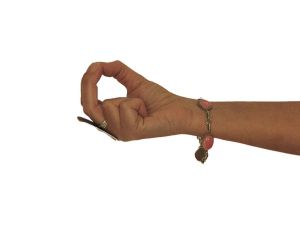 3) Garuda Mudra Garuda è l'uccello mistico cavalcato dalla divinità indiana Vishnu. Si tratta di una posizione delle mani molto potente, utilizzata per attivare la circolazione, rafforzare gli organi e ritrovare l'equilibrio tra la parte destra e sinistra del corpo. Va praticata con moderazione da chi soffre di pressione alta. 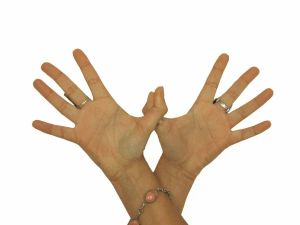 4) Mudra contro l'asma Gli esperti raccomandano di tenere le mani in questa posizione per cinque minuti al giorno per prevenire le crisi. Può essere usato anche in caso di fase acuta per calmare il respiro. 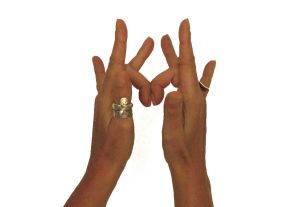 5) Kaleshvara Mudra Questo sigillo è dedicato alla divinità che governa il tempo e serve a calmare l'ansia e gli stati di agitazione. Aiuta a trovare calma e concentrazione: ottimo in ufficio prima di cominciare un lavoro intellettuale. 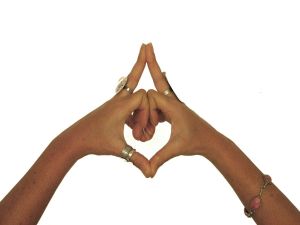 6) Pran Mudra È il mudra della vita. Nutre, accresce il livello energetico e riduce la fatica. Sarebbe bene praticarlo al mattino. Alcuni esperti dicono che serve anche a migliorare la vista e può essere usato in casi di disturbo agli occhi. 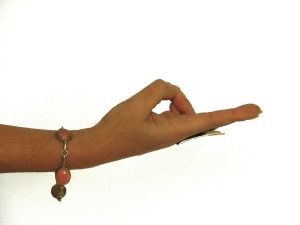 7) Bhramara Mudra Il suo nome deriva da una danza indiana ispirata all'ape, viene praticato in caso di allergie. Rafforza il sistema immunitario, la cui debolezza è considerata una delle prime cause di reazione allergica. Per prevenire questo disturbo primaverile è molto importante l'azione combinata di dieta, abitudini di vita sane ed esercizi specifici di yoga. 8) Gesto della fiducia incrollabile Rafforza uno stato di centratura fisica, mentale ed emotiva. Aiuta a rallentare il flusso dei pensieri e a ritrovare la forza interiore per avere fiducia in se stessi e affrontare le sfide quotidiane. (ENGLISH VERSION) Health, energy and mental clarity are in our hands. This is the principle of the Mudra, the sacred seals practiced for over five thousand years to the search for balance between mind, body and spirit. From gesture to get rid of an spring allergy attack practice to alleviate anxiety, or ease fatigue, mudras are an example of "manual therapy" without contraindications. Each finger positions stimulates the reflex points that are in the hands, experts say, drawing a geography of the palm and fingertips that reflects the health of the internal organs, the nervous system, the mental and emotional state. Through the practice of mudras we are therefore seeking an agreement with the various parts of the body towards closer integration and awareness. This advised the teachers, who use it to strengthen the meditation techniques, but in fact it is also recommended in the life of every day: - at work,
- on public transport,
- in the waiting room of a dentist or
- on the couch.
Since it involves mainly the hands, it becomes a solution in the case of - flu,
- fractures,
- back pain and
- in situations where we are forced to immobility and waiting.
The mysterious origin of mudras is lost in Asia. Some mudras involve the whole body including the eyes, but the symbolic value of the gesture of the hands is considered important across the world starting from the colorful footprints made 40 thousand years ago in the prehistoric caves of northern Spain to the classic gesture of peace, or even the positions taken by Christian priests in blessing, preach and celebrate mass. Is not exempt from this practice even the last Pope elected, Francis, who makes gestures of hands an important corollary to the words. If the simple gesture adds emphasis to a speech, move your hands in a conscious way helps us not only to achieve greater flexibility and strength in the end, but it affects the whole body helping to solve minor problems and emotional situations difficult. Each gesture can be practiced several times a day and should be retained for a few moments until a maximum of 15 minutes, bringing attention to the internal sensation. You can practice standing, sitting, lying down while walking and even during a walk. Earlier some positions may seem unexpectedly strenuous. Hands are rebels sometimes refusing discipline, as well as body and mind. With exercise you can improve flexibility and strength strengthening of muscles, tendons and ligaments in the end, together with the overall health of the whole organism. You just have to try it. 1) Hakini Mudra It is the recommended position for managers and public figures and, in any case, who is set to make a public speech. It is often practiced unknowingly: promotes the integration between the right and left brain and helps to restore the forgotten words.  2) Kubera Mudra Kubera is the god of wealth. This hand position is generally used to solve everyday problems or to give more strength to the projects for the future. Infuses inner peace, serenity and confidence. 3) Garuda Mudra Garuda is a mystical bird ridden by the Indian deity Vishnu. It is a very powerful position of the hands, used to activate the circulation, strengthen the organs and find the balance between the right and left of the body. It should be practiced in moderation by those suffering from high blood pressure. 
4) Mudra against asthma Experts recommend that you keep your hands in this position for five minutes a day to prevent seizures. It can also be used in case of acute phase to calm the breath. 
5) Kaleshvara Mudra This seal is dedicated to the deity who rules the time and is used to calm anxiety and agitation. It helps to find calm and concentration: excellent in the office before starting an intellectual work. 
6) Pran Mudra It is the mudra of life. It nourishes, increases energy levels and reduces fatigue. It would be good practice in the morning. Some experts say it also serves to improve eyesight and can be used in cases of eye problem. 
7) Bhramara Mudra Its name comes from an Indian dance inspired the bee, is practiced in case of allergies. It strengthens the immune system, whose weakness is considered a leading cause of allergic reaction. Prevent this spring is very important to the combined effects of diet, healthy lifestyle habits and specific exercises of yoga. 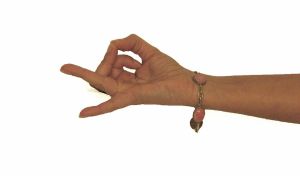
8) Gesture of confidence unshaken Strengthens a centering physical , mental and emotional state. It helps to slow down the flow of thoughts and find the inner strength to have confidence in themselves and face the daily challenges.

SOURCE: HuffingtonPost | |
|
|
|
 entra
entra
Nessun commento:
Posta un commento